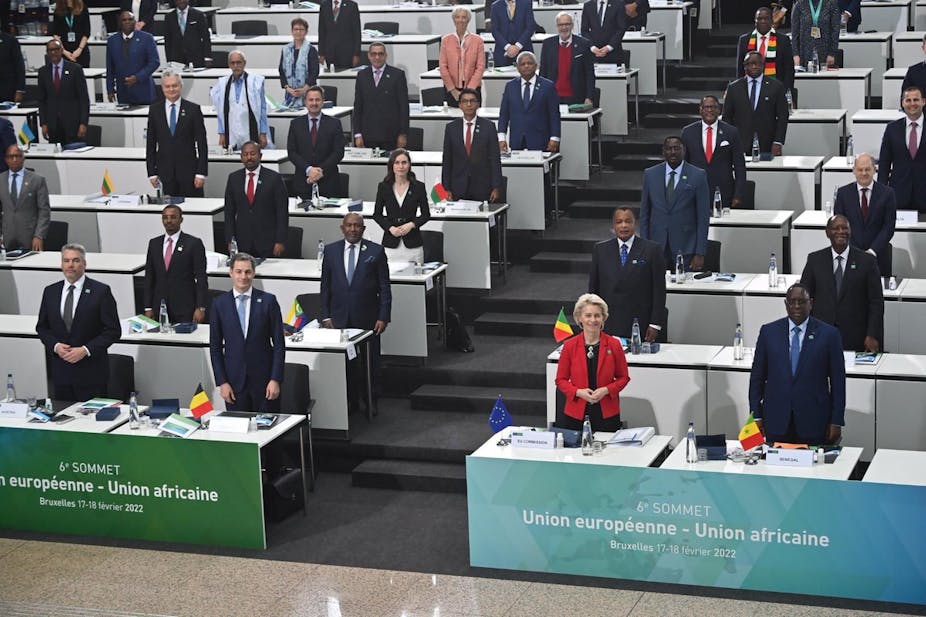At the recent 6th AU-EU summit, the European Union (EU) and the African Union (AU) unveiled five partnerships highlighting their Joint Vision till 2030.
The five partnerships are: green transition and energy access, digital transformation, sustainable growth and jobs, peace and governance and migration and mobility.
The genesis of their partnership on migration and mobility goes back to the Joint-Valletta Action Plan that was signed in November 2015 in the wake of the refugee crisis. That autumn hundreds of thousands of Syrian, Afghan and Eritrean asylum seekers crossed into Greece from Turkey, and into Italy from Libya. The EU called an emergency meeting with African countries to try and find a long lasting solution.
The meeting was attended by countless heads of government, NGOs, international organisations, AU and EU officials.
My colleague Eileen Lamptey and I, analysed the content of the Joint Valletta Action Plan and evaluated its implementation until 2021.
We found that the phrase that emerged from the meeting was “shared responsibility”. This highlighted the parties´ recognition of their interdependence. While each party held onto its interests (territorial integrity for the Europeans and economic development for the Africans), there was a new sense, especially on the part of the more powerful Europeans, that both parties needed each other’s help and co-operation to advance these interests.
This policy shift was evident in the domains of action that were agreed around migration.
We found only a limited gap in policy implementation. The policies on the paper were put in place and their results so far have been mostly positive. We concluded that they constituted a break with the past and progress in the EU-AU migration dialogue.
The implementation score card
The domains of action around migration were:
migration and development
legal migration and mobility
protection and asylum
prevention of and fight against irregular migration
return, readmission, and reintegration.
The first two domains were “African domains” while the last two were “European domains.” The third domain was of equal importance to both parties but advantageous for the Africans.
A funding instrument worth Euro 3,6 billion was created - the EU Emergency Trust Fund for Stability and Addressing the Root Causes of Irregular Migration and Displaced Persons in Africa.
Africa’s primary domain – migration and development – benefited from sufficient funding from the fund. The 2019 Annual Report of the Trust Fund disclosed that its implementation had been “swift and effective” , and less than 2% of the sums disbursed were ineligible.
The main European domain – the prevention of and fight against irregular migration – saw the disruption of illegal immigration networks and a sharp decline in clandestine immigration. According to the UNHCR, the United Nations’ refugee agency, the numbers dropped from 153,842 in 2016 to 10,565 in 2019 before the COVID-19 pandemic.
In the domain of protection and asylum, more than more than 48 000 asylum seekers were repatriated. This was done under the AU–EU–UN Tripartite Taskforce on the Situation of Stranded Migrant and Refugees in Libya which was launched in 2017.
Some areas fell short of expectations. These included regular migration and mobility – an African domain. And the return, readmission and integration – a European domain.
This shows that bolder action is needed.
A broader paradigm shift?
In my view the deliberations at the 6th AU-EU summit looked very much like those of the 2015 Valletta summit. EU leaders laid the same emphasis on interdependence, concrete immediate actions and a reset of their relationship with the AU.
The tone of the summit suggests that Europeans want to cooperate with Africans with a new mindset based on pragmatism and not pompous announcements. They also want agreement on concrete action based on Africans inputs.
At the opening ceremony of the AU-EU summit, Emmanuel Macron, the president of France and the EU rotating presidency spoke of forging “a new alliance”.
Charles Michel, the EU council president, declared that the summit was not “business as usual” but “the step that cements the renewal of [EU-AU] strategic relation. The example he used was the use, for the first time, of roundtable sessions at the summit. These were designed to foster frank discussion as well as fast and concrete decisions.
And talking about the partnership on peace and governance he said:
security in Africa and in Europe are interdependent.
The EU Commission president, Ursula von der Leyen announced an investment budget worth 150 billion until 2021 drawn from the Global Gateway initiative, EU’s response to China’s Belt and Road Initiative.
In his reply, Macky Sall, Senegal president and the current AU chairman requested, as a concrete measure, the use of the European Peace Facility, an off-budget instrument that allows the EU to swiftly support military initiatives in favour of global peace.
Moussa Faki, the AU Commission chairman underscored the need for new monitoring and evaluation procedures, arguing that "the partnership needs visible and tangible results” for Africa cannot content itself anymore with the fashionable label of “being the continent of the future”.
On this point too, the Joint-Valletta Action Plan introduced an innovative system of evaluation based on the new EU Evaluation Framework and consisting of regular monitoring on the ground, quarterly or yearly evaluations at regional level (Sahel and Lake Chad, Horn of Africa and North Africa) and timely evaluation of the Trust Fund as a whole.
If the implementation of the other four partnerships follows the same playbook as that of the Joint-Valletta Action Plan, by the time they meet again, AU and EU member states could be talking of the first fruits of their renewed partnership. The EU and AU would do well to use the plan as a template for all the agreements they have struck.

